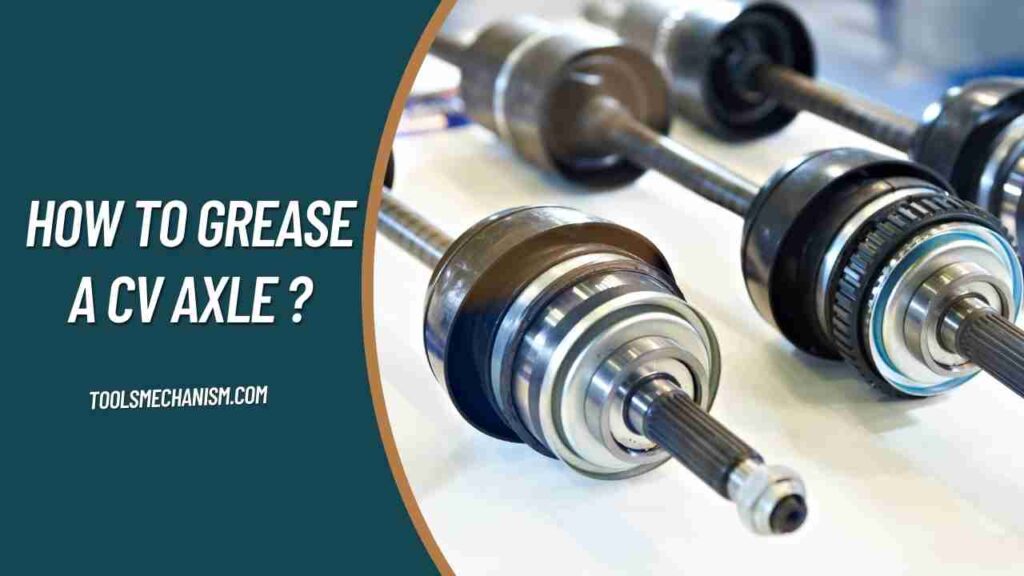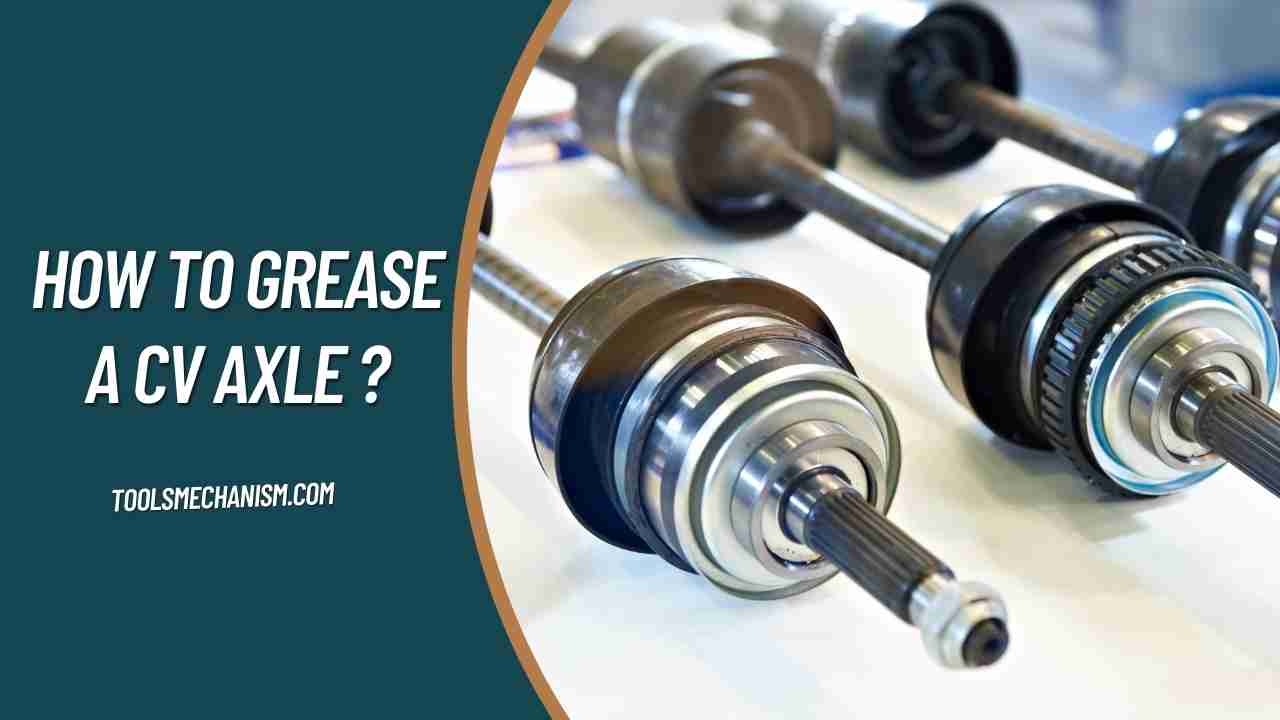How To Grease A CV Axle: Never underestimate the fact that every rotatory part of automobiles needs lubrication. Indeed, the differential parts of vehicles are not left out in any way in this discourse.
The axle is part of the differential system that’s connected to the wheels. Its presence is conspicuous in front-wheel and four-wheel drive vehicles. All these require lubrication from the axle assembly to the piston, shafts, and gears.
Of course, this differential system enables you to control the wheels at different speed rates, and you must grease the transmission part of the differential system, which includes the axle assembly, to get the apt inference.
Thus, the differential system is connected to the transmission through the driveshaft. Notwithstanding, the part of the axle assembly that’s connected to these two compartments is the CV axle.
Table of Contents
Why Proper Greasing is Critical for Your CV Axle’s Health
Before we dive into the “how-to,” it’s essential to understand why this maintenance task is so important. The Constant Velocity (CV) axle is a critical drivetrain component that transfers power from your vehicle’s transmission to the wheels, while also accommodating the up-and-down motion of the suspension and the turning of the wheels. Inside the CV joints at each end of the axle are a series of bearings and cages that are in constant, high-friction motion.
The specialized CV joint grease serves three vital purposes. First, it provides extreme-pressure lubrication to prevent metal-on-metal wear and catastrophic failure of the bearings. Second, it helps to dissipate the immense heat generated by this constant friction. Third, it protects the precision-machined internal components from moisture and contaminants, which can cause rust and corrosion.
Over time, or if the protective rubber CV boot tears, this essential grease can break down, become contaminated with dirt and water, or simply leak out. When this happens, the joint quickly begins to wear out, leading to the tell-tale clicking or popping sound when turning. Ignoring this issue will ultimately lead to complete CV axle failure, which is a much more expensive and complex repair than simply re-greasing the joint.
How to Grease a CV Axle? 7 Easy Steps
- The essential part is accessing the axle assembly at the vehicle’s front and rear. Therefore, start by getting the wrenches and screwdrivers needed available.
- Remove the battery terminals and remove the battery from the bonnet. Use the wrench to remove the wires from their respective terminals.
- Next, you’re to disconnect the brake line of the vehicle. Use the 14mm wrench to loosen the banjo bolt on the strut or central pipe where the brake may be found and disconnect the brake line thereafter.
- You should access the axle assembly once you remove the wheel caliper, intuitively remove the nuts that hold each CV axle, and access the CV joint.
- Take hold of the boot and remove old grease by inverting its position to enable the grease to flow out. Check the boot and see if it hasn’t turned or become damaged.
- Use a brush to clean the dirt that may be cleaving on the rubberized sleeve of the axle. You can also use the tip of the screwdriver to remove rusts lingering on the joint. This should be done on all the CV axles of the car to scoop the correct result.
- Use your grease gun to infuse new grease into the protective layer. Tighten up the bolt and fix the CV axle back to its former position while you reassemble the whole compartment of the vehicle.
What is a CV Axle?
How To Grease A CV Axle? The CV axle is fully called the constant velocity axle. It connects the wheel’s sensitivity through the differential components to the transmission.
It’s acknowledged as the essential sensor collector that keeps the speed rate of front wheels constant per time. The CV axle is the shaft often found at the front wheel and sometimes the back wheel. There are boots on the sides of the CV axles.
The boots are rubberized with sleeve designs, connected to the wheels on both sides of the vehicle. A rod often separates the middle of the two ends of each axle. As it’s been called, the half shaft is partially connected to the transmission to enable the other end to turn the tires quickly as controlled through the driveshaft.
What Does the CV Axle do?
How To Grease A CV Axle? They are present in front-wheel and four-wheel vehicles. They are part of the axle assembly that makes the wheels turn at a constant velocity.
The engine power is conveyed to the wheel through the axle. The essence is to give the wheel the proportional torque power emanating from the engine through the transmission to get the wheels revving.
It’s the boot you’re to grease to boost the performance of the CV joint. The joint protrudes from the CV boot on both sides of the vehicle, and it’s nut to the wheels to give it the control required. The boot is sealed with either rubber or plastic to prevent the permeation of dirt or water.
Do You Need to Grease CV Axles?
How To Grease A CV Axle. Yea, you’re to grease CV axles to maintain the performance of the suspension system and the vehicle’s differential system. Learn how to grease a CV axle the right way with our step-by-step guide. We cover the tools you’ll need, the right type of grease, and common mistakes to avoid.
In fact, clinking sounds emanate once the axle isn’t lubricated. If the lubrication isn’t done on time, you could find CV joints splatter on brakes, wheels, shock absorbers, and so on.
Obviously, greasing the CV joint on time is extremely important to prevent further spoilage of some essential parts of the vehicle. The grease keeps the protective layers intact while they spin.
Beyond the mere greasing of the axle, lubricating the CV axle properly is crucial to get a lasting result. Use suitable grease for your CV axle.
What Grease to Use in CV Axle?
How To Grease A CV Axle. Lithium grease is the most suitable grease for CV joints. You wouldn’t want to use oil because it could ebb out of the boot. The protective layers in the boot require lithium grease because they can withstand high temperatures and enable them to slide smoothly.
The graphite and molybdenum constituents give optimum thermal stability. It could withstand a temperature of 260 degrees Fahrenheit.
Furthermore, lithium grease is waterproof and recommended for heavy-duty lubrication. Buy from a reliable source to have an appreciable result.
How much Grease Goes in a CV Axle?
This could be done cognitively. You’re not to fill the axle to the brim. All that’s needed is to ensure the moving part of the CV joint is greased. Some new CV axles come with grease in a sachet enough to lubricate the moving parts in the joint’s protective layers. Better still, you can use the grease gun to apply the lubricant. How To Grease A CV Axle

Final Words
Follow these instructions, and you’ll arrive at the juncture of your expectation. Don’t lubricate haphazardly. Moreover, don’t wait for the axle to screech before applying the grease. Instead, lubricate all the boots simultaneously to scoop the ultimate result.
Nevertheless, don’t hesitate to dispose of the CV axle if the rubberized sleeve is turned or damaged. Trash it and replace it with a new one as soon as possible. Learn how to grease a CV axle the right way with our step-by-step guide. We cover the tools you’ll need, the right type of grease, and common mistakes to avoid.
Frequently Asked Questions
Question 1: What type of grease should I use for a CV axle?
Answer 1: You must use a specialized grease specifically formulated for CV joints. This is typically a high-temperature, extreme-pressure (EP) grease containing Molybdenum Disulfide (“Moly”). Do not use standard wheel bearing grease, chassis grease, or any other general-purpose grease, as they cannot withstand the unique stresses and temperatures of a CV joint.
Question 2: How do I know if my CV axle needs new grease?
Answer 2: The most common sign is a torn or cracked rubber CV boot. If you see grease splattered on the inside of your wheel or around the axle, the boot is compromised and the joint needs to be cleaned and re-greased immediately. Another major symptom is a clicking or popping noise when you are making sharp turns.
Question 3: Can I just add new grease without cleaning out the old grease?
Answer 3: No, you should never just add new grease on top of old. The old grease is likely contaminated with dirt, water, and tiny metal particles from wear. To do the job correctly, you must completely disassemble the CV joint, thoroughly clean all of the old grease and contaminants from every component with a solvent, and then repack it with fresh grease.
Question 4: How much grease do I need for one CV joint?
Answer 4: A single pouch of CV joint grease, which typically contains about 90-100 grams (around 3 ounces), is usually the perfect amount for one joint. The goal is to pack the joint and the inside of the boot thoroughly so that all moving parts are coated, but without overfilling it to the point where it could damage the new boot.
Question 5: Is it possible to grease a CV axle without taking it off the car?
Answer 5: While it is technically possible in some cases, it is highly **not recommended** for a proper job. To grease a CV joint correctly, you must remove the old, contaminated grease first. This requires disassembling the joint, which is nearly impossible to do while the axle is still on the vehicle. Some “boot kits” come with tools that allow you to inject grease into a torn boot as a temporary, emergency repair. However, this is not a long-term solution because it traps the old, dirty grease and contaminants inside, which will continue to cause wear. For a durable and reliable repair, you should always remove the axle to thoroughly clean and repack the joint.

